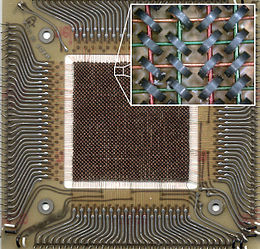RAM

Source:
http://www.secsavvy.com/wp-content/uploads/2010/11/RAM.jpg
The Birth of Software
The first computer memory system was invented in 1947 by William Kilburn and was nicknamed the Williams Tube. In the past, memory was the main problem computer scientists faced when they wanted to develop automation for the computer. With the invention of The Williams Tube, it enabled computer scientists to store a program on a computer's memory and have it access that program every time a problem needed to be solved.The Williams Tube was essentially a cathode ray tube with a screen at one end. The screen provided a medium that would allow the cathode ray to excite certain particles and make electrical signals visible via green dots. When a particular area of the screen was excited, it stored a charge and made that particular part of the screen light up with a dot. In terms of computing, a green dot represented the binary digit one while the faint dots represented binary zeros.
After much effort, William Kilburn and his team were able to make a functioning computer capable of storing 1000 bits of memory compared to the previous 1 or 2 bits of memory other computers possessed at the time. With this "abundance" of memory, Kilburn and his team were able to write a simple arithmetic program that would spit out a binary value on the cathode screen. These values were then compared to the accepted value after being translated from their binary representation. After multiple trials and correct outputs Kilburn's program was confirmed to be the first working piece of software in history. Often times, this event is referred to as the birth of software and the computer developed by Kilburn is usually called "The Baby".
"The Baby"

Magnetic Core Memory
Following the development of the Williams Tube was magnetic
core memory. Magnetic core memory consists of a chip with
multiple conductive rings on it, each ring representing one
bit of information. Current could be sent in two directions
through these rings which would create a magnetic field in
either the clockwise or counterclockwise position. Depending
on the magnetization direction, the bit stored in the ring was
represented as a binary zero or one.
When reading from magnetic core memory, the computer would
check the magnetization direction and return the corresponding
binary value associated with the ring being read. The ring
would then be erased and reset to zero in a process called
destructive readout. Using this method meant data storage was
sound until new data had to be written or read.
In both William's Tubes and Magnetic Core Memory storage, the
memory being accessed can be obtained randomly and does not
have to be in order hence, they fall in the category of random
access memory (RAM). Advantages of storing data in this
fashion is that the computer has the liberty to read and write
data to and from anywhere. It is often faster on average to
pick or search for data starting at some place other than the
beginning of memory. Take for example a data strand of 100
bits and you want to find the contents of the 75th bit, it
would be faster to increment starting at the 50th or 67th bit
rather than counting up from the 1st bit. Thus RAM is faster
than other memory storage systems because it can jump anywhere
in memory compared to traditional methods of sequentially
reading or writing data one at a time until what is needed is
found.
Magnetic Core Memory Storage

-Notice the density of the rings on a single chip. Each ring represents one bit of data.
source "magnetic core memory" : https://upload.wikimedia.org/wikipedia/commons/thumb/d/df/Ferrite_core_memory.jpg/260px-Ferrite_core_memory.jpg